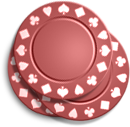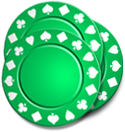



The way a player handles their chips and cards can reveal a lot about their general attitude towards the game as well as their current state of mind. The only way to get a really good feel for a player by observing their handling styles is to practice, but here are some common things to look out for.
1. When a player puts their smallest chips into the pot they could well be holding an equally small hand, or merely a drawing hand. Small chips are often viewed as "change" that is quite separate from the main stack, so whilst they may not want to speculate with a larger denomination, they might feel that their smallest chips are worth fluttering with.
2. When a player puts larger denomination chips into the pot when they have smaller denominations available, they are probably holding a much stronger hand. With small denominations still viewed as "change", betting a larger denomination indicates that they want to bet some serious money in order to win a bigger pot.
3. Players who create careful stacks of chips that just happen to be the same size as the blinds are usually preparing to see a lot of hands. This tells you quite a bit about the kind of game they intend to play - generally a loose one that involves calling more often than not. If this is confirmed after a few hands, you can adjust your play by betting only when you have a fairly strong hand - bluffing probably won't work with these players unless you get extremely aggressive.
4. If a player throws chips into the pot forcefully enough to make a fairly loud noise, they are probably feeling pretty strong if not aggressive about their own hand. This is definitely a sign for you to exercise caution if you are bluffing.
Although the above signs can be useful, be aware that an intelligent player could use their handling of chips to give a false impression. For example, a player with a strong hand could bet with his smallest chips to lure you into a false sense of security. Another player could deliberately throw his chips into the pot to look aggressively confident when he is actually bluffing. Knowing your opponent will help you to determine if their chip handling style is likely to be a genuine reflection of their mindset or just a clever attempt to deceive you.
1. When a player looks at their hole cards after the flop, the chances are that they are looking to see if they have a straight or flush draw, or whether they have made a small or medium pair. Strong hole cards such as A-K, J-J, Q-K and so on are fairly memorable, so they probably wouldn't be checking to see if they've made a pair of aces or kings. Of course, some players look at their hole cards all the time, in which case this observation is of little help to anyone.
2. If a player takes an initial look at their hole cards and immediately bets or raises with no hesitation, the chances are they have a strong hand or are initiating a bluff. How they play after the flop and your experience of that player will help you to determine which is the case.
As always, the more knowledge you have about particular players, the better. If you play the same opponents week after week, you can soon build up a useful knowledge of their specific patterns of behaviour. Be sure to observe the chip and card handling habits of everyone you play even when you are not active in a hand. What you learn from by observing a game in which you have folded could well help you to take the pot in future hands.

